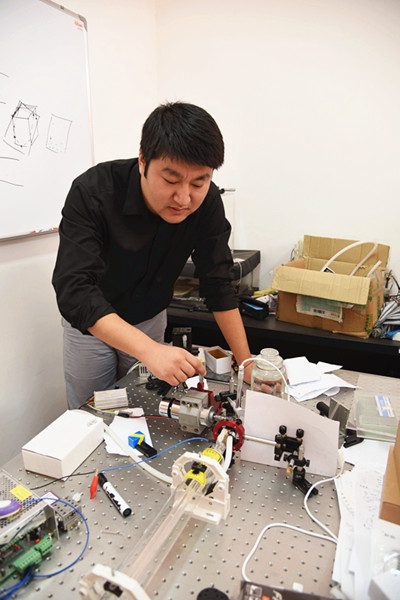University of Michigan- Shanghai Jiao Tong University Joint Institute (UM-SJTU JI) Assistant Professor Wenjie Wan and UM Professor Xiaogan Liang have recently developed a SERS (surface enhanced Raman spectroscopy )-based atmospheric monitoring sensor using nanoimprint technique of the IoT (Internet of Things) technology. The project has been awarded by 2015 Shanghai Science and Technology Innovation Program in International Cooperation, the first for JI.
As another technological revolution after the Internet, the emerging Internet of Things technology opens a new door for industry innovation and integration, and will become a major opportunity for integrating the industry and information technology. Based on this, Wenjie Wan’s team turns their research attention to the increasingly serious air pollution problem in China, where emission of nitric oxide, carbon monoxide, ammonia, ethane and other harmful gases has been monitored by existing techniques. They hope to be able to effectively monitor the atmosphere in real-time through a combination of IoT technology and sensitive gas sensors, and quickly locate and report the polluting sources to environment-protection agencies. Sensors are the core of IoT technology but the existing gas sensing technique using methane, formaldehyde, acetylene and other gas absorpting surface that affects the conductivity of semiconductor sensors have the problems of limited sensor selectivity and vulnerability to outside influence. Gas chromatography sensing technique is difficult to combine with IoT technology because of its complex gas-flow structure for various types of gas, as well as its need to comply with other optical or electrical detectors, which involves high cost.

To solve this problem, Wan’s (left) plan to study the use of Raman spectroscopy for optical gas measurement provides an alternative: using the medium ‘s unique Raman scattering characteristics can detect a variety of gases at the same time. With the invention of surface-enhanced Raman spectroscopy technology, the sensitivity of this type of sensing method is enhanced. The project partner, Professor Xiaogan Liang of the University of Michigan, is an expert in the core technology of the nanoimprint division of micro- nanofabrication. The partnership will produce a small sensor with radically reduced cost.
The bilateral collaboration has been solid. This year, Wan and Liang have jointly published an article on the study of biosensors using the technique of binding molybdenum disulfide with microfluidics in Nature Scientific Reports, a branch of Nature. Another important outcome of their cooperation will also be published in the journal Scientific Reports in 2015.
Wenjie Wan is the principal investigator of the project. He joined JI in 2011 as Assistant Professor, with dual appointment as Special Researcher in the Department of Physics at SJTU. His research interests include nonlinear nano-optics. His research papers have been published in internationally renowned journals, including Science, Nature Physics, Nature Photonics, Physics Review Letters and he has been invited to review a number of world-class journals. In 2011, his completed project ” “Time-reversed lasing and control of absorption in a two-channel coherent perfect absorber” was voted by the Chinese Academy of Sciences and Chinese Academy of Engineering as one of “World ‘s top ten scientific and technological innovations.”





